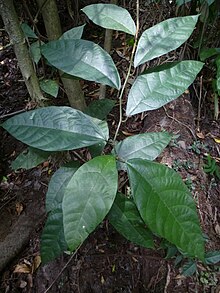| Ficus asperifolia | |
|---|---|

| |
| Scientific classification | |
| Kingdom: | Plantae |
| Clade: | Tracheophytes |
| Clade: | Angiosperms |
| Clade: | Eudicots |
| Clade: | Rosids |
| Order: | Rosales |
| Family: | Moraceae |
| Genus: | Ficus |
| Species: | F. asperifolia |
| Binomial name | |
| Ficus asperifolia Miq. | |
| Synonyms | |
List
| |
Ficus asperifolia is a species of shrub or small sized gynodioecious fig tree belonging to the family Moraceae. It grows up to 6 m high and often has climbing branches.
Description
Leaves of the species are elliptical to obovate in shape, up to 20 cm long and 8 cm wide, apex is long and acuminate while base is cuneate to obtusely rounded. Leaves commonly have stipules; petiole is up to 1 cm long and margin tends to be lobed or dentate. Peduncles, 2–15 mm long, the figs are orange to purplish red, up to 2 cm in diameter and globular in shape; figs are sometimes paired or single on leaf axils.
Distribution and habitat
Ficus asperifolia occurs in Senegal westwards to Sudan and Kenya and southwards to Zambia. It is found in savannahs and edges of gallery forests.
Uses
In Cameroon dried fruit of the species are used in traditional medine to treate infertility, extracts of the species are also used to aid the wound healing process.
References
- ^ Watcho, Pierre; Meli Watio, Hermine; Wankeu-Nya, Modeste; Ngadjui, Esther; Deeh Defo, Patrick; Nkeng-Efouet, Pepin Alango; Nguelefack, Telesphore Benoit; Kamanyi, Albert (2017). "Androgenic effects of aqueous and methanolic extracts of Ficus asperifolia in male Wistar rats". BMC Complementary and Alternative Medicine. 17 (1): 42. doi:10.1186/s12906-016-1547-5. ISSN 1472-6882. PMC 5237287. PMID 28086774.
- Verkerke, W., L987(a). Ovule dimorphism in ficus asperifolia Miquel . Acta Bot.Neer-I . 36: L2L-L24
- Beentje, H. J. (1988). "Fig trees (Ficus, Moraceae) of Kenya". Journal of the East Africa Natural History Society and National Museum. 76 (198): 53–76.
- ^ Ndolo Ebika, S. T.; Morgan, D.; Sanz, C.; Harris, D. J. (2018-08-09). "Ficus Species in the Sangha Trinational, Central Africa". Edinburgh Journal of Botany. 75 (3): 377–420. doi:10.1017/S0960428618000173. ISSN 1474-0036.
- ^ Arbonnier, Michel; Arbonnier, Michel (2004). Trees, shrubs and lianas of West African dry zones. CIRAD. Weikersheim: Margraf Publ. pp. 397–400. ISBN 978-3-8236-1419-7.
| Taxon identifiers | |
|---|---|
| Ficus asperifolia |
|